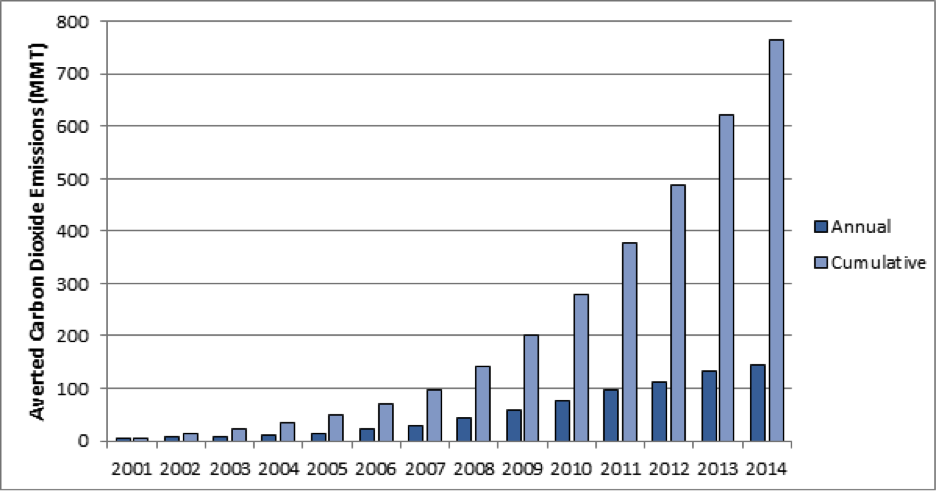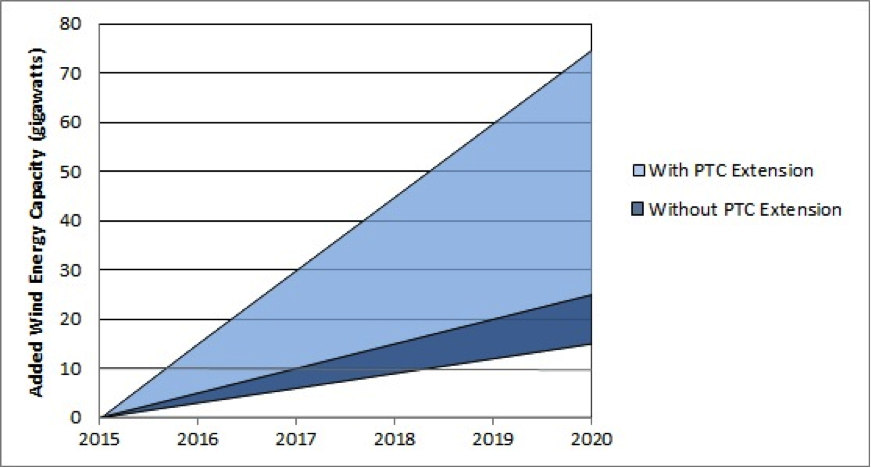Turning to the Wind
American Wind Power is Cutting Carbon Pollution Today and Paving the Way for a Clean Energy Future
Wind power continues to grow as a source of clean energy across America. The United States generated 26 times more electricity from wind power in 2014 than it did in 2001. American wind power has already significantly reduced global warming pollution. In 2014 alone, wind-generated electricity averted an estimated 143 million metric tons of carbon dioxide emissions – as much as would be produced by 37 typical coal-fired power plants. With America’s massive potential for wind energy on land and off our coasts, wind power can play a key role in meeting the emission reduction targets of the recently adopted Clean Power Plan and moving the nation toward a future of 100 percent renewable electricity.
Downloads
Executive Summary
Wind power continues to grow as a source of clean energy across America. The United States generated 26 times more electricity from wind power in 2014 than it did in 2001. American wind power has already significantly reduced global warming pollution. In 2014 alone, wind-generated electricity averted an estimated 143 million metric tons of carbon dioxide emissions – as much as would be produced by 37 typical coal-fired power plants. With America’s massive potential for wind energy on land and off our coasts, wind power can play a key role in meeting the emission reduction targets of the recently adopted Clean Power Plan and moving the nation toward a future of 100 percent renewable electricity.
To take advantage of that potential, however, the nation must create a public policy environment that is supportive of continued wind energy growth. Long-term renewal of federal tax incentive programs for renewable energy, including the Production Tax Credit and the Investment Tax Credit for wind energy, both of which expired at the end of 2014, can help the United States maintain momentum in the fight against global warming.
Wind power has already significantly reduced climate-altering carbon pollution.
- Since 2001, wind power in the United States has displaced more than 764 million metric tons of carbon dioxide – more than a year’s worth of CO2 emissions from the entire country of Canada.
- After more than a decade of rapid growth, wind energy accounted for 4.4 percent of total U.S. electricity generation in 2014.
- Nine states – Colorado, Idaho, Iowa, Kansas, Minnesota, North Dakota, Oklahoma, Oregon and South Dakota – generated more than 12 percent of their total electricity production with wind power in 2014.
- In 2014, wind power in Iowa and South Dakota accounted for over a quarter of in-state electricity generation.
Figure ES-1. Carbon Dioxide Pollution Displaced by Wind-Generated Electricity, 2001-2014

By renewing the Production Tax Credit, America can displace even more carbon pollution – a critical step towards protecting future generations from the worst impacts of global warming.
- The uncertainty created by the on-again, off-again Production Tax Credit has undermined steady progress on wind energy. Since its inception in 1992, the credit has expired a number of times, including at the end of 2014.
- A recent analysis by the National Renewable Energy Laboratory found that renewing the Production Tax Credit would add between 10,000 and 50,000 MW of wind capacity to the U.S. energy grid by 2020, compared with projected levels of wind capacity in the absence of the tax credit.
- Depending on overall electricity demand and the prices of competing fossil fuels, the Production Tax Credit would avert between 4.2 and 20.8 million metric tons of additional carbon dioxide per year from 2016 through 2020. That is a total of between 20.8 and 104.2 million tons of avoided carbon dioxide pollution by 2020.
Figure ES-2. Estimated Impact of PTC Renewal on Wind Energy Capacity through 2020

By expanding opportunities for offshore wind energy, America can further reduce carbon pollution.
- Offshore wind energy is a proven technology that currently provides carbon-free electricity for several European and Asian countries.
- The construction of America’s first offshore wind facility—the 30 MW Block Island Wind Farm in Rhode Island—began in July 2015. The project is expected to begin operations by the end of 2016.
- Several offshore wind projects in Atlantic states have reached advanced development stages and are scheduled to begin commercial operations by 2020. Energy generated by these projects could offset over 9.3 million metric tons of carbon dioxide in 2020. That’s equivalent to the annual emissions of nearly 2 million passenger vehicles.
Wind energy is reducing America’s contribution to global warming now, and can do so even more in the future. To take advantage of America’s vast wind energy potential:
- The federal government should establish a consistent, predictable and supportive public policy playing field for renewable energy, including the long-term extension of key policies such as the Production Tax Credit and the Investment Tax Credit, which helped drive the explosion of wind growth over the last 10 years.
- State and federal governments should set ambitious goals for the steady expansion of wind energy and adopt renewable electricity standards consistent with those goals.
- State and federal agencies should coordinate to expedite the responsible development of offshore wind facilities, ensuring strong environmental protections throughout the development process.
- The federal government should defend the Clean Power Plan and both the federal government and state governments should ensure that wind power plays a key role in its implementation.

